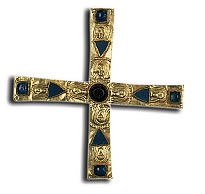Scientific Area » Longobard Culture » The Crisis and the Attractiveness of the Old Culture
« Back
THE CRISIS AND THE ATTRACTIVENESS OF THE OLD CULTURE
In cities impoverished both in demographic and economic terms, the urban landscape was dominated by imperial palaces, walls, amphitheatres, theatres, circuses and religious complexes which, thanks to the conservatism of the Church were the only to be maintained, thus testifying the continuity of those functions and institutions ruling over them.Besides, the architectural quality was also affected by:
- the transformation of professional corporations which adapted themselves to the new means of production and, in Italy after the Longobard invasion (568-569), to new purchasers;
- the transport and market squeeze which in building industry led to an increasing use of local raw materials (stone and wood) as well as the reuse (whereas in the Roman age the effective trade system had ensured a large scale circulation of building noble materials transferred from Greece and Asia Minor to Rome and Gaul, guaranteeing the homogeneity of style which had characterized religious architecture from early 4th to early 6th century).
In the second half of 6th century the crisis became unrestrainable. After the Gothic War with Greece (533-552) the changes occurred to (mainly religious) architecture were tangible: structures were rescaled, perimeter support structures and vaults changed; the building technique using the petit appareil (small cubical stonework) made up of rough-hewed stones and cobbles from both rock blasting and reused materials from old buildings became increasingly popular; marble wall decorations were replaced by painted plaster; mosaic, marble and stucco works were reserved for civil and religious buildings of particular value, purchased by high-ranking clergy and leaders.
Technical differences concerned the various geographical areas; in Gaul and some regions of Spain, for example, the stone sources of supply were still the Pyrenees quarries.
The splendour of churches and basilicas and their accurate maintenance would be over the following centuries a major source of inspiration for Germanic decision makers, who were continuously putting their culture and organization to test, as they were obliged to change their tradition, deal with the old leaders, rich in experience and attractiveness (bishops, pope, emperors and high Byzantine aristocracy) and at the same time keep their ancestral originality alive.
In Italy the Longobard kings together with decision makers and the clergy pledged from early 7th century to restore Palaeochristian basilicas symbolizing traditions by using bricks produced in royal factories and tiles bearing their name (e.g. the restoration of the Basilica of San Simpliciano in Milan by kings Agilulf and Adoloald).
The attractiveness of the old world caused Agilulf to associate his son with the throne with a typically Byzantine ceremony held in the circus of Milan (604) before a number of Frankish representatives.

Whereas bishops (see Isidore of Seville, Gregory of Tours) and monastic orders, with such highly charismatic figures as St. Benedict, St. Columbanus and St. Martin, played in the Early Middle Ages a major role in politics and in the spread of ancient culture by acting as a connecting link, Germanic royal families arranged marriages contributing to a further circulation of ideas and solutions alongside that of the clergy. Hence numerous cross-references and interrelations.
In Italy the experience of the Longobard monarchy was marked by the foundation of a number of basilicas, monasteries and royal palaces (all built in early 7th century and lost over time), mentioned by Paul the Deacon in chronological order under the name of the founding kings. One of the most popular buildings was the Palace of Monza commissioned by Queen Theodelinda, of Bavarian origin, who had it frescoed with stories relating to Longobard customs and traditions.
The Hellenistic and Roman culture indeed attracted the new Longobard rulers to the point that they at first imitated it and then took possession of it: the attraction to an aesthetic elegance of a universally intelligible culture turned into a recovery-renovation of the old as an expression of the status symbol which emphasized both the rank and the role of the possessor.
In terms of communication forms, the aforesaid change compared the Germanic nobles not only to the pope, bishops, emperors and Byzantine aristocracy but also, in certain respects, to the activity promoted in Gaul by the Merovingian kings (e.g. the Palaeochristian basilica of St. Denis, which was built on Roman waterworks, used as a mausoleum by the Frankish royal family in late 6th century; the abbeys of Jourre sponsored by both St. Columbanus, the founder of the monastery of Bobbio, and the land aristocracy in early 7th century) and in Spain by the Aryan Visigoth monarchs (e.g. the churches of S. Pedro della Nave, Quintanilla de las Viņas, San Juan de Baņos in Spain, sponsored by Visigoth kings including Recceswinth, who ascended the throne in 653 with the support of the bishop of Zaragoza.
« Back


